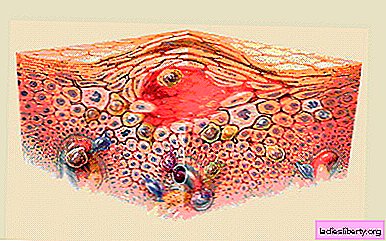
Eczema is a chronic skin disease of a neuro-allergic nature. It is characterized by serous inflammation of different layers of the epidermis, manifested by severe itching and a rash of affected areas of the skin. According to statistics, eczema accounts for approximately 40% of all skin diseases. As a rule, eczema begins in childhood and becomes chronic with improper treatment. In medicine, eczema is distinguished by microbial, childhood, true, seborrheic, professional, dyshidrotic.
Eczema - Causes
It is impossible to single out one of the causes of eczema. The disease is the result of a complex effect on the body of endocrine, neuroallergic, exogenous (external) and metabolic factors.
The main causes of eczema:
- a hereditary predisposition to an allergic reaction;
- hormonal (endocrine) disorders;
- immune disorders;
- diseases of the liver, gastrointestinal tract, foot mycoses;
- in children, eczema manifests itself against the background of atopic dermatitis and essential diathesis, starting at a very early (infant) age;
- Often the development of eczema is provoked by nervous shocks and stresses;
- professional factors: work in food and pharmaceutical industries, chemical enterprises and metallurgical plants. The reaction to substances used in production develops over time, but then becomes stable;
Eczema - Symptoms
Externally, eczema manifests itself in different ways, however, it is isolated in a separate disease due to its characteristic manifestations - a large number of vesicles that form on the skin. Bubbles merge and open, visually resembling bubbles of boiling water. Later on in these areas weeping foci of inflammation or crust are formed. A characteristic manifestation of eczema is severe itching.
True eczema begins with redness of the skin (erythema), rashes are usually symmetrical and spread to the skin of the trunk, legs and arms;
Microbial eczema is the result of an infection (streptococcal or staphylococcal) in people with weakened immune systems. Such eczema is manifested by asymmetric clearly defined scaly areas that are covered with crusts.
Children's eczema usually begins with rashes on the scalp and facial skin, from where it spreads to other parts of the body. Rashes are possible in the area of inguinal-femoral and gluteal folds.
Seborrheic eczema appears on the scalp, between the shoulder blades, on the face and in the chest area. The presence of yellowish, greasy scales is characteristic.
Eczema - diagnosis
The diagnosis of eczema is based on anamnestic data, a clinical picture and, in doubtful cases, a histological picture. The differential diagnosis is carried out with toxidermia, dermatitis, mycoses and psoriasis.
Eczema - treatment and prevention
Treatment depends on the form and cause of eczema, for this, a timely visit to a dermatologist is recommended, in some cases, an examination. Previously, patients were prescribed sedatives, desensitizing drugs, vitamins, spa therapy and diet. Locally prescribed pastes, lotions, antipruritic drugs and ointments.
Currently, doctors are widely used in the treatment of eczema external forms of corticosteroid hormones. Ointments with antibiotics are used for microbial infections, with fungal infections, these ointments are contraindicated. Antihistamines are used to relieve itching.
Prevention of eczema cannot completely prevent the possibility of a disease, however, it significantly reduces the percentage of risk. Timely treatment of seborrhea and dermatitis, as well as the elimination of allergens, is recommended. With occupational eczema, any contact with chemicals should be avoided. It is very important to avoid stressful situations and adhere to a healthy lifestyle.











